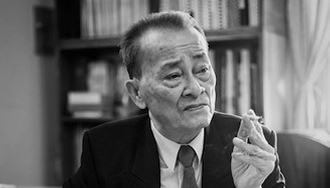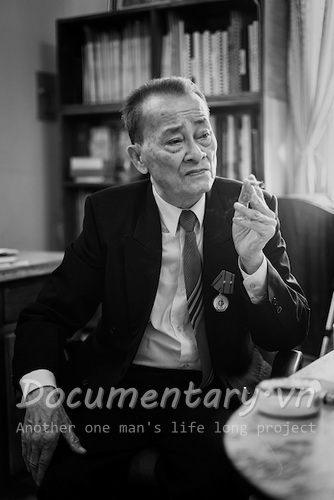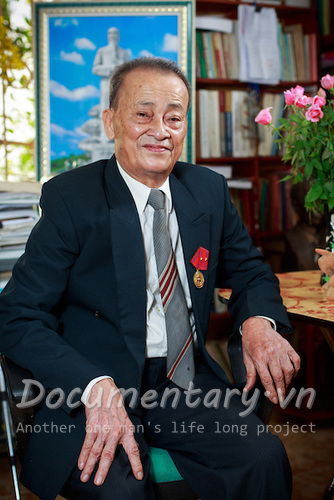
Due to his childhood destiny, the young man Hoang Van Khoan learned Chinese characters since he was a toddler and learned French in elementary school. After years of hardship, he worked as a tutor in exchange for food to go to Huong Khe Secondary School. When he entered high school, he was selected to study at the Central School District in Nanning (China). After graduating, he was sent to Ha Tinh to teach. Then he was sent to study Archaeology at Khac Cop University (Soviet Union). In 1974, he successfully defended his doctoral thesis in Archaeology at the Soviet Academy of Sciences, and was one of the first three doctors of the Faculty of History. In 1967, he became a lecturer at Hanoi University, and despite holding many different management positions and experiencing many ups and downs of economic life, he has always been attached to the Faculty of History since then.

Associate Professor, Dr., People's Teacher Hoang Van Khoan was Deputy Head of the Department of History (1977-1986)/Photo: Thanh Long
Physiognomy and metallurgy were the fields that Associate Professor Dr. Hoang Van Khoan first pursued when entering the archaeology profession. His doctoral thesis in the Soviet Union was on the topic of iron research in the tribes of South Siberia. After returning to Vietnam, he applied much of the knowledge he had learned to research in Vietnam. His research in the 1970s and 1980s on the Nghi Xuan iron smelting area, on iron smelting and iron making techniques in Vietnam, on ancient Vietnamese bronze alloys, on Dong Son bronze drum casting techniques, on experimental iron production processes in ancient times in Nho Lam and on the appearance of cast iron in Vietnam... still holds its value today.
Vietnamese historical archaeology is one of the research contents that Associate Professor Dr. Hoang Van Khoan has been pursuing for a long time until now. In particular, from the beginning, he focused on researching the Co Loa region. The bookCo Loa - The center of Red River civilizationThe editor-in-chief has determined the important position of Co Loa in the process of forming the Au Lac state of An Duong Vuong based on the foundation of the system of Pre-Dong Son and Dong Son cultural relics in the surrounding area.
The history of Vietnamese architecture and sculpture is also an important research content in the career of Associate Professor Dr. Hoang Van Khoan. In the bookLy-Tran pagoda architecture, art of architecture and sculptureis a general way to come to a unified view of pagodas and towers in the Ly-Tran period in particular and of Buddhism in the Ly-Tran period in general. From there, he showed his in-depth research on sculpture, Buddhist content as well as the socio-economic, political, cultural and ideological situation... At the same time, he saw the results of the cultural exchange between Vietnam-India, Vietnam-Champa and Vietnam-China in the process of forming the unique characteristics of the Ly-Tran period. Besides, he always highly valued the teaching of this important body of knowledge to students and postgraduates. Therefore, in the Faculty of History, he is one of the rare "old teachers" who always leads students and postgraduates to visit famous architectural relics of Vietnam such as Thang Long Imperial Citadel, Ho Dynasty Citadel, Lam Kinh, Phat Tich Pagoda, Thay Pagoda, Tay Phuong Pagoda, Phat Diem Stone Church...
In the 2000s, whenever domestic archaeological researchers came to the 18 Hoang Dieu construction site, they all knew about the two "money-making old men". One was the ancient coin expert Do Van Ninh and the other was Associate Professor, Dr. Hoang Van Khoan. However, Associate Professor, Dr. Hoang Van Khoan's research on ancient coins also started quite early and he also achieved certain achievements. Since the 1990s, he has visited many museums and many private collections, researched and published about many ancient coin collections. On that basis, in 2010, he published the bookHandbook of ancient metal coins of Vietnam, China, Japan, France circulating in Vietnam from the beginning of the Christian era to 1975. This is a handbook of ancient coins of countries that were once circulated in Vietnam, an important dictionary for researchers of ancient numismatics and museum studies in Vietnam. From the perspective of ancient numismatics, he also expanded his research to commercial fields through different feudal dynasties.

Associate Professor, Dr., People's Teacher Hoang Van Khoan is a leading expert in archaeology/Photo: Thanh Long
Experimental archaeology is also one of the important research contents that Associate Professor Dr. Hoang Van Khoan is interested in pursuing and has achieved important results. Particularly noteworthy among them is the experiment of recasting the Co Loa bronze plowshare and conducting experimental plowing with that plowshare on many different types of fields in Dong Xuat village. The experimental results completely proved the use of the type of artifact that archaeologists were previously confused about whether to call it a plowshare or a hoe. Another experimental research result of Associate Professor Dr. Hoang Van Khoan is to restore the weaving profession of Dong Dau people through the weaving system on pottery.
For Associate Professor Dr. Hoang Van Khoan, students are truly “God”. Surely many generations of students of the Faculty of History know that his office is always lit up to welcome all students, even late at night his voice is still clear and passionate in discussing new scientific ideas. Until a few years ago, although he was not as strong as before, just a lesson guiding students to write a scientific report made him use his enthusiasm to hobble with a cane to take students on field surveys. Until 2014-2015, the octogenarian man twice used a cane to take a sleeper bus for several days to the Lao People's Democratic Republic to guide graduate students to write their Master's Thesis. That enthusiasm not only made students feel respected by him, but many other teachers also admired his scientific spirit.
One thing that many generations of students of the Faculty of History all know is that after retiring, the Teacher still diligently studied. The Han Nom classes organized by him, invited Mr. Nguyen Huu Tuong (a staff member of the Han Nom Institute) to his house to teach, he studied with the students, and even when the Han Nom class went to practice at temples and pagodas and stamped steles, the Teacher often went with the thought in mind.go, teach, learn. The teacher's principle when opening these classes was very clear: to study and do history, one must know Han Nom, and it must be practical Han Nom, not scriptures. Many of our brothers who do history today know and use Han Nom documents quite well, partly thanks to these classes of the teacher.
Associate Professor Dr. Hoang Van Khoan has participated in training many generations of students, trainees and postgraduates majoring in archaeology at the Faculty of History, University of Social Sciences and Humanities, Vietnam National University, Hanoi. In particular, he has made many contributions to training officials for the Lao and Cambodian governments, such as students That Xam Ri, Thoonglith Luangkhoth, Thoong My, PhinXeng, Thao Kham Man, Soiliphane Bouraphane... In addition, he also participated in writing the curriculum for Phnom Penh University; participated in teaching and writing textbooks for Hanoi University of Culture, Central Youth Union, Senior Officers School, Hue University, Ho Chi Minh City National University...
The spirit of solidarity, cohesion, daring to do and daring to take responsibility is one of the most noble qualities that Mr. Hoang Van Khoan respects. For him, “honesty” is the ultimate standard of an archaeologist, of a historian, and that is the first lesson for every student from the first contact with the teacher.
Hanoi,Valley Rain Festival 2015
|
PAssistant Professor, Doctor, People's TeacherHOANG VAN KHOAN
+ Work unit: Faculty of History. Department of Organization and Personnel. + Management position: Deputy Head of the Department of History (1977-1986). Deputy Secretary of the Party Committee, Head of Organization Department, Hanoi National University (1988-1993).
The Mystery of the Underground, Unesco Center for Information, Documents and History of Vietnam, Hanoi, 1999. Ly-Tran pagoda architecture, art of architecture and sculpture (written together), Culture and Information Publishing House, Hanoi, 2001. Co Loa - The center of Red River civilization(editor-in-chief), Culture and Information Publishing House, Hanoi, 2002. Handbook of ancient metal coins of Vietnam, China, Japan, France circulating in Vietnam from the beginning of the Christian era to 1975(written together), Department of Cultural Heritage Publishing, Hanoi, 2010. Numismatics and Vietnamese Ancient Coins(editor-in-chief), Labor Publishing House, Hanoi, 2014. |
Author:Dr. Dang Hong Son
Newer news
Older news